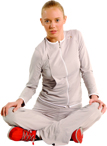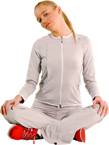Exercising to relieve aches
One of the best ways to relax the body and mind –a basic treatment for female discomforts– is physical exercise. A guide with the exercises specifically recommended for pregnant women and women undergoing menopause hass been put together for you.
+ Physical exercise helps to regulate neuroendocrine activity and blood circulation and helps in the distribution of minerals in the bones. Before starting any exercise program, it's recommended:
- • Consult your doctor and have a medical checkup.
- • Don't eat during the two hours before exercising.
- • Always warm up for 20 minutes (exercise bike, cycling or walking) to prevent injuries.
- • Use comfortable cotton clothing and good sports shoes.
MUSCLE RELAXING EXERCISES
Before and during menstruation, our bodies tend to build up nervous tension particularly in the shoulders and neck, making us feel achy and heavy. To release tension these simple, loosening exercises may also be beneficial during menopause and pregnancy.
10 GOOD REASONS FOR WORKING OUT
1. Fortifies your immune system.
2. Decreases your risk of cardiovascular disease.
3. Improves your mood and humor.
4. Improves your sleep and mental clarity.
5. Keeps your weight under control, not only your weight is lowered with regular exercise, your anxiety is lowered and your appetite is regulated.
6. Fights against headaches and backaches.
7. Increases the level of HDL or “good cholesterol” in your blood system.
8. Strengthens your bones and helps to prevent osteoporosis.
9. Increases your muscular resistance and mass, which improves your balance and prevents injuries and broken bones.
10. Prevents type II diabetes (adult diabetes).
Shoulders

Sitting with your back straight and your arms relaxed to your sides, gently roll your shoulders forward and backward, slowly and smoothly.
Neck

1. Sitting with your legs crossed, hands on your knees and back straight, roll your head in slow circular movements, five times to the right and five to the left, breathing deeply and slowly as you perform the exercise.

2. Start with your head centered and facing forward, gently move your head backward only to where it's comfortable. Breathe in and hold your breath; then, breathe out. Concentrate on how your neck feels as it stretches and your throat zone opens.
NOTE
Every woman requires a different type of training according to her age and physical state. Before starting any exercise program it is important that you visit your doctor for a physical checkup so that he or she can recommend appropriate exercises, how often you should do them and if you need to take any special precautions.
DURING PREGNANCY
- • It's recommended that you continue with a regular exercise routine during pregnancy because it provides a number of benefits: increases your energy, keeps and improves blood circulation and flexibility. It also improves your posture, increases your awareness of your body and your physical movements. Walking, swimming and aqua aerobics are recommended exercises.
- • During pregnancy you should avoid high impact aerobic exercises, involving jumping or running and contact sports such as hockey or volleyball. At the same time, it's best that you consult your doctor before exercising during pregnancy.
- • Swimming and aqua aerobics. Swimming is an excellent sport during pregnancy, it doesn't involve any risk, because muscular exercises in the water don't involve impact or joint resistance. It improves your breathing and keeps your muscles toned and your joints flexible. You should avoid very cold or hot water; appropriate temperature is between 77 to 90°F/25 to 32°C.
- • Walking. Walking is a great way to keep your muscles toned, improve your blood circulation and breathing and keep your cardiovascular system healthy, without straining your body.
EXERCISE AND PREGNANCY
Not every type of exercise is appropriate during pregnancy. Weight training and aerobics classes are not advised, even if you were regularly practicing them before getting pregnant. Recommended workouts include stretching, yoga, rhythmic dance and classical ballet, but they should be practiced moderately and using caution.
IMPORTANT

When you are working out during pregnancy you should keep in mind:
- • Your pulse shouldn't go over 140 beats per minute. Never do intense exercises for more than 15 minutes at a time.
- • Avoid any exercises involving rolling, jumping or bouncing.
- • If you experience any pain or complications, stop exercising and immediately visit your obstetrician.
- • Don't overheat your body.
TO RELIEVE BACK PAIN
1. Lie on the floor on your back. With one leg stretched out, and the other with the knee to your chest. Wrap your hands around your knee and hug your leg into your chest. Stay in this position for a few minutes and then repeat with the other leg.

2. Lie down in the same position, bring both of your knees to your chest and hug them. Stay in this position for a few minutes and then relax. Practice these exercises for as long as you feel comfortable. Never strain or use force.

DURING MENOPAUSE
- • It's been proven that after 40 years-old our bodies begin to lose muscular mass; making walking, biking, swimming or rowing the most recommended aerobic exercises for this age group. It's important for your body to make weight bearing movements, to strengthen the bones, especially in the hips. You should do any of these exercises at least three times a week.
- • If you suffer from osteoporosis, a low-risk activity is biking on an exercise bike, to avoid falling and possible broken bones.
- • It's best to increase the time and rhythm as you build your stamina over time. Over exerting yourself during a high impact or intense exercises may cause injuries, muscle cramps or sprains. It's not recommended that you participate in sports involving jumping, running or races.
SPEED WALKING
When you start out its best to use a moderate pace and then build up your stamina for a few months before speed walking. If you haven't exercised in a while, start with a 10 to 12 minute walk, adding a minute per week, until you build up to an hour three times a week. After walking it's important that you stretch out to avoid muscular pains and to improve your flexibility. You can use your arms while walking; overtime you can add hand weights of between 2 and 4 pounds.

Comment about this article, ask questions, or add new information about this topic: